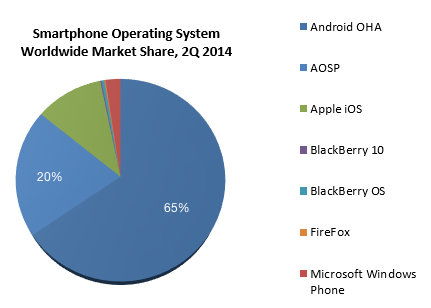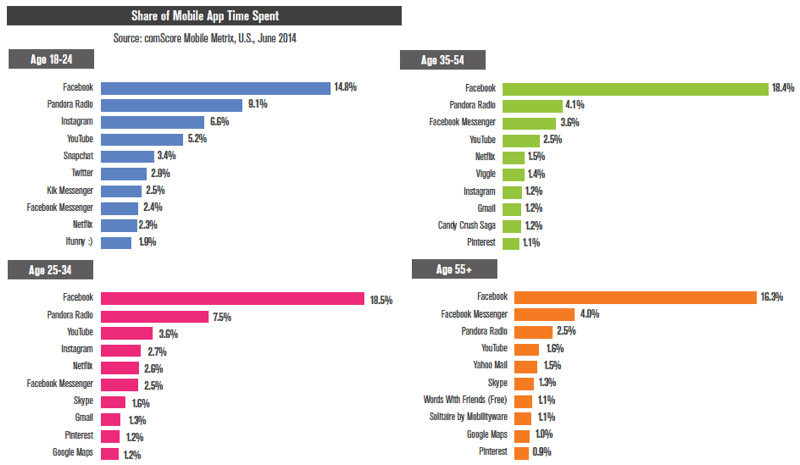Apple should make Android apps
The idea is not as unthinkable as it sounds. Read on!
Who is the main competitor for Google’s Android OS? If Apple’s iOS came to mind, it would be wrong.
Android’s main competitor is Android.
Android has two main “flavors”: There is Google’s version that they use on their Nexus devices and license to manufacturers like LG and Samsung under their Open Handset Alliance. The other is AOSP — Android Open Source Project — that anyone can fork and use as they wish. Amazon’s Kindle Fire is the most well known (at least in the US) of AOSP forks. AOSP devices are not supported by Google, and have some additional restrictions. Read this for more details about the two: Android AOSP vs OHA.
According to a recent report from ABI Research, AOSP is the 2nd most popular smartphone OS and growing faster at 20% quarter-over-quarter than OHA which is growing at 13%.

Top two smartphone OSes are Android
The main attraction for a manufacturer to use Google’s OHA Android (while submitting itself to the severe restrictions imposed by OHA’s T&C) is to include Google’s ecosystem on the phone — Google apps like Maps, Youtube, etc. and perhaps more importantly, Play Store and all the apps that come with it.
But are Google apps a big draw for users?
If you look at Comscore’s latest US Mobile App report, YouTube is the only app that shows up consistently in the top apps used in the US across all age groups. GMail and Maps appear for some age groups, but near the bottom. The absence of Google’s apps in the 18-24 age group is perhaps most telling, as those users are a leading indicator for the app economy.

YouTube is the only app consistently among the top used
In large markets like China or India, Google would be even less important.
That leaves the app store (the Play Store), and services that support 3rd party apps — such as distribution through an app store, push notifications, ability to charge users for app downloads or in-app purchases, etc. Also, given how Apple and Google have been battling it out for the exclusivity of apps on their platforms, it would indicate that apps are indeed important to device sales. Not being able to download and play Candy Crush Saga on your new phone could make you return the phone immediately.
The Play Store and Google Play Services could be a deterrent for manufacturers — particularly those making phones for the western markets — from using AOSP and an incentive to use Google’s OHA version instead.
However, generally speaking, it is really a rich app store and services that allow 3rd party apps to be discovered and paid for that are key for the ecosystem.
Apple has both of these. And some essential apps as well – Safari, Mail, iMessage, Maps (okay, perhaps maps not quite yet!), books & music — everything that makes iOS a great platform.
Posit: any one who wants an iPhone has an iPhone.
When the gold iPhone 5s launched in the US, the going rate for an iPhone in India (before Apple launched it there) was 2x-3x the full USD price. $2,000 for a smartphone is unbelievable! Price elasticity for iPhones seems to be non-existent. I bet Apple has figured this out which is why you haven’t seen a cheaper iPhone yet and likely won’t any time soon (I realize the danger of making an Apple prediction the week before they have an iPhone event!).
I’d argue that Apple has won in its playing field and should set its eyes on the larger smartphone market.
If Apple wants a foothold in this “other” smartphone market and give Google a run for its money there, the best thing it can do is participate in the Android ecosystem. This entails launching an Android version of the iTunes AppStore, providing Android in-app payment SDKs, and releasing Android versions of its iOS apps (at least the popular ones).
App developers would be more than willing to make a few lines of change to their existing Android apps to make it “andrTunes” (you heard this word here first, folks) compatible.
This would certainly make it easier for manufacturers to choose AOSP, as well as get a large userbase into Apple’s ecosystem. The other incentive would be app revenue: Android’s app revenue isn’t as big as iOS’, but if Play Store app revenue is an indicator at 11 digits annually and gaining ground on iOS revenue, it is certainly not to be scoffed at.
Of course, I don’t expect Apple to do any of this. Apple is good at hardware, and bad at software services. Besides, they like to own the entire stack themselves and shun open ecosystems. However, they did shift from this once before — by launching iTunes for Windows (apparently not without some internal drama) — and it worked out marvelously well for them.
On the other hand, Amazon has been quietly building up its Android app store, and mobile developer services. Facebook too is going big on developer services – their recent F8 was all about mobile and Parse is perhaps the most popular mobile BaaS. I wouldn’t be surprised to see Amazon or Facebook start giving strong competition to Google in mobile.